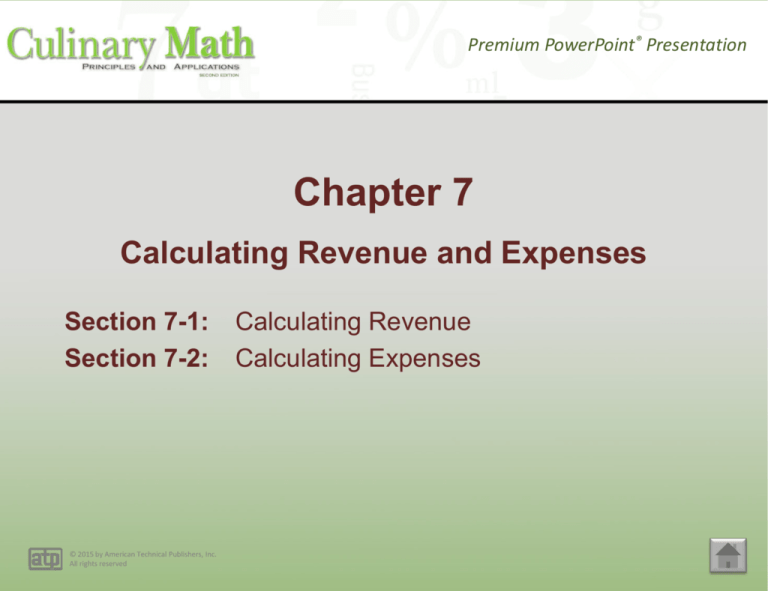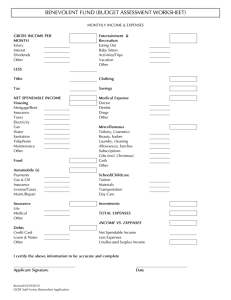
Premium PowerPoint® Presentation
Chapter 7
Calculating Revenue and Expenses
Section 7-1:
Section 7-2:
© 2015 by American Technical Publishers, Inc.
All rights reserved
Calculating Revenue
Calculating Expenses
Chapter 7 — Calculating Revenue and Expenses
Section 7-1: Calculating Revenue
Objectives:
• Explain how a guest check is processed.
• Calculate discounts, sales taxes, guest check totals, and
gratuities.
• Explain the purpose of a point-of-sale (POS) system.
• Demonstrate how to return change to a customer who
pays with cash.
• Explain how daily sales revenue is calculated and
recorded.
© 2015 by American Technical Publishers, Inc.
All rights reserved
Chapter 7 — Calculating Revenue and Expenses
A guest check lists the
items ordered by a
customer, the prices to
be charged for those
items, and the total
amount of money due.
© 2015 by American Technical Publishers, Inc.
All rights reserved
Chapter 7 — Calculating Revenue and Expenses
All of the charges are added to calculate the subtotal of
charges for food and beverages.
© 2015 by American Technical Publishers, Inc.
All rights reserved
Chapter 7 — Calculating Revenue and Expenses
The total on the guest check is calculated by subtracting the
discount from the subtotal and then adding the sales tax.
© 2015 by American Technical Publishers, Inc.
All rights reserved
Chapter 7 — Calculating Revenue and Expenses
A point-of-sale (POS) system is a computerized system used
to process customer orders, print guest checks, track daily
operations, and generate financial reports.
© 2015 by American Technical Publishers, Inc.
All rights reserved
Chapter 7 — Calculating Revenue and Expenses
The amount of change given
to the customer should be
equal to the difference
between the amount of cash
presented for payment and
the total amount of the guest
check.
© 2015 by American Technical Publishers, Inc.
All rights reserved
Chapter 7 — Calculating Revenue and Expenses
Most foodservice operations calculate sales revenue on
a daily basis.
© 2015 by American Technical Publishers, Inc.
All rights reserved
Chapter 7 — Calculating Revenue and Expenses
Checkpoint 7-1
1. Define revenue.
2. Describe the purpose of a guest check.
3. What is a point-of-sale (POS) system?
4. What is the food and beverage subtotal on a guest
check that contains the following order: two sandwiches
for $7.95 each, one salad for $6.95, and two desserts
for $4.50 each?
5. What would be the discount on the order in the previous
question if the customers had a coupon good for 15%
off their entire food and beverage order?
…continued on next slide
© 2015 by American Technical Publishers, Inc.
All rights reserved
Chapter 7 — Calculating Revenue and Expenses
Checkpoint 7-1 (continued)
6. If the food and beverage subtotal on a guest check is
$45.50 and the sales tax is 9%, what is the total of the
guest check?
7. How much would a 15% gratuity be on a guest check
with a food and beverage subtotal of $60.50?
8. If a customer pays with a $50.00 bill and the guest
check total is $37.50, how much change should be
returned to the customer?
…continued on next slide
© 2015 by American Technical Publishers, Inc.
All rights reserved
Chapter 7 — Calculating Revenue and Expenses
Checkpoint 7-1 (continued)
9. When completing a daily sales record, if the cash at the
end of the day is $1240.50 and the cash at the start of
the day is $250.25, what is the total cash revenue for
the day?
10. On a daily sales record, if a restaurant records gross
sales of $3276.65 and a total revenue of $3300.80,
would the report be over or short and by how much?
© 2015 by American Technical Publishers, Inc.
All rights reserved
Chapter 7 — Calculating Revenue and Expenses
Section 7-2: Calculating Expenses
Objectives:
• Describe the different expense categories of a foodservice
operation.
• Calculate the value of inventory.
• Calculate the cost of goods sold.
• Explain how payroll expenses are calculated.
• Explain the difference between variable and fixed
expenses.
© 2015 by American Technical Publishers, Inc.
All rights reserved
Chapter 7 — Calculating Revenue and Expenses
The many expenses incurred by a
foodservice operation can be broken
down into three general categories:
• capital expenses
• cost of goods sold
• operating expenses
© 2015 by American Technical Publishers, Inc.
All rights reserved
Chapter 7 — Calculating Revenue and Expenses
Inventory value is
determined by counting
the food and beverage
items in storage and
multiplying the number
of units of each item by
their as-purchased unit
costs.
© 2015 by American Technical Publishers, Inc.
All rights reserved
Chapter 7 — Calculating Revenue and Expenses
Calculating Inventory Value
IV = NU × AU
where
IV = inventory value
NU = number of units
AU = as-purchased unit cost
© 2015 by American Technical Publishers, Inc.
All rights reserved
Chapter 7 — Calculating Revenue and Expenses
When the cost of goods sold is greater than the amount of
food and beverage purchases it indicates that the amount
of inventory was reduced during the period.
© 2015 by American Technical Publishers, Inc.
All rights reserved
Chapter 7 — Calculating Revenue and Expenses
Calculating Cost of Goods Sold
GS = BI + IP – EI
where
GS = cost of goods sold
BI = beginning inventory
IP = inventory purchases
EI = ending inventory
© 2015 by American Technical Publishers, Inc.
All rights reserved
Chapter 7 — Calculating Revenue and Expenses
To calculate the total payroll expenses for a foodservice
operation, the gross pay of each employee is added together.
© 2015 by American Technical Publishers, Inc.
All rights reserved
Chapter 7 — Calculating Revenue and Expenses
The difference between gross pay and net pay is equal to the
sum of the payroll deductions.
© 2015 by American Technical Publishers, Inc.
All rights reserved
Chapter 7 — Calculating Revenue and Expenses
Variable expenses vary based on sales while fixed expenses
are not tied to sales.
© 2015 by American Technical Publishers, Inc.
All rights reserved
Chapter 7 — Calculating Revenue and Expenses
Checkpoint 7-2
1. Define capital expense.
2. Define cost of goods sold.
3. What is the inventory value of a 50-pound case of
whole chickens if the as-purchased unit cost of whole
chickens is $1.15 per pound?
4. If a banquet hall has a beginning inventory value of
$20,500, makes $125,000 in food and beverage
purchases, and has a month-ending inventory value of
$35,000, what was the cost of goods sold that month?
5. Define operating expense.
© 2015 by American Technical Publishers, Inc.
All rights reserved
…continued on next slide
Chapter 7 — Calculating Revenue and Expenses
Checkpoint 7-2 (continued)
6. What is the gross pay for the week of an hourly
nonexempt dishwasher who earns $9.00 per hour and
works 52 hours in that week?
7. Define net pay.
8. What is the monthly rent on a 4000 square foot
restaurant if the rent is $20 per square foot per year?
9. List three utilities that could be considered operating
expenses in a foodservice operation.
10. Explain the difference between a variable expense and
a fixed expense.
© 2015 by American Technical Publishers, Inc.
All rights reserved
Chapter 7 — Calculating Revenue and Expenses
Chapter 7 Summary
• Revenue is the amount of money received by a
foodservice operation from sales to customers.
• Guest checks are used as a tool to document the items
sold to customers, the prices of those items, and the total
amount of money due.
• Foodservice workers need to know how to perform
calculations involving discounts, sales taxes, and
gratuities to process guest checks.
…continued on next slide
© 2015 by American Technical Publishers, Inc.
All rights reserved
Chapter 7 — Calculating Revenue and Expenses
Chapter 7 Summary (continued)
• Point of sale (POS) systems are commonly used to
process guest checks and to collect information related to
inventory status, menu item profitability, payroll expenses,
and overall finances.
• Controls and documentation must be set in place to
ensure that the actual amount of money received from
customers is equal to the amount of sales documented on
guest checks each business day.
• Expenses related to buildings and equipment can be
classified as capital expenses.
…continued on next slide
© 2015 by American Technical Publishers, Inc.
All rights reserved
Chapter 7 — Calculating Revenue and Expenses
Chapter 7 Summary (continued)
• The cost of goods sold relates to the purchase of food
and beverage ingredients.
• Operating expenses are incurred in carrying out day-today operations.
• Payroll expenses are the most significant expenses of a
foodservice operation.
• Calculating payroll involves understanding the different
classifications of employees.
• Some expenses vary based on the amount of sales while
others remain relatively constant.
© 2015 by American Technical Publishers, Inc.
All rights reserved




